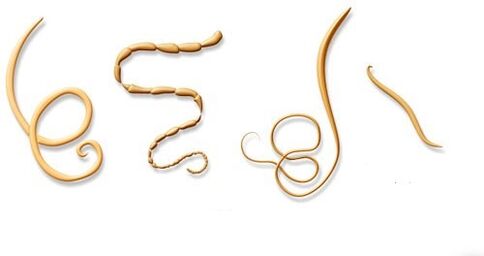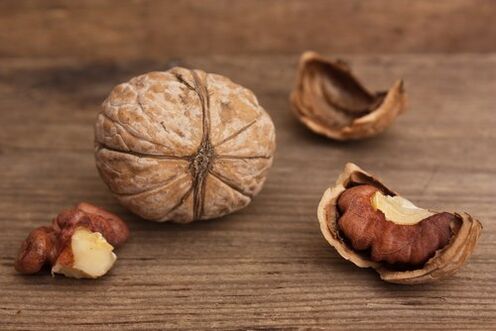Parasites are the simplest organisms that live at the expense of humans. They use cells, vitamins, substances, tissues for nutrition - everything that is good for our health.
In addition, parasites are known to poison the body by releasing harmful substances. Let's take a closer look at the signs of the presence of parasites in the human body, their habitats, how to get rid of them and protective measures against their appearance.
Damage from parasites in the body
First of all, the functioning of the organs is impaired, ie inflammation occurs, which destroys the tissues. These creatures, which are often alien to us, produce toxins that, over time, help to poison the whole organism.

Microorganisms living in the intestines feed on food that enters the stomach. As a result, the first symptom of the presence of a parasite in the body appears: a person has a slowdown in growth, impaired mental and physical development.
Parasites have the ability to live for years, and eggs with larvae are very resistant to the surrounding microflora.For example, the digestive system releases substances that neutralize food-processing enzymes during metabolism.
After that, digestive processes are disrupted. Therefore, sometimes the symptoms of the presence of parasites in the human body are often similar to gastrointestinal diseases.
Common parasites
The most common human parasites are:
- lice- the bite of these arthropods first irritates the skin, then turns into eczema or purulent lesions;
- pinworms- small round white worms that cause a disease such as enterobiasis;
- roundwormsare parasitic worms whose vital activity occurs in the intestinal tract. The length of a sexually mature male is 24 cm and that of a female is 40 cm;
- whipis the third most common disease. Infection with this parasite causes a disease - trichocephalus. The teeth of this parasite are large, reaching 5. 5 cm, the male is slightly smaller - 4-5 cm;
- Giardia- live in two structures: vegetative and spore forms. In the first case, their vital activity takes place in the upper part of the small intestine, in the second - in the large intestine;
- cat mixture- affects the liver and causes opisthorchiasis;
- Trichinella- roundworms. Causes helminthic infestation;
- toxocara- like a round worm, only the diameter of the larva is 0, 02 mm;
- intestinal acne- fibrous parasite up to 2 mm long;
- nekator- toothed worm larvae enter the body through the pores of the legs when walking barefoot. Their path begins in the right atrium and ends in the pulmonary artery. They break the walls of the capillaries and enter the alveoli and from there into the pharynx through the respiratory tract.

Ways of infection
You can be infected in different ways. Each of them is associated with the development period of a particular parasite. But there are 3 main sources of infection in medicine:
- With food and water.However, contamination often occurs due to improper storage and preparation. However, sometimes there is an initial infection, ie when a product infected with parasites undergoes poor heat treatment;
- By contact-home method.In this case, the infection is transmitted from another person or pet;
- Through blood-sucking insects.This road is also known as a pass;
- With pets walking on the street.

There are larvae that can enter the human body independently. One symptom of the presence of a parasite in this form is dermatobiasis. In this condition, the larva enters the skin, gnaws on itself, and enters the host's body.
Signs of parasites
Here are 10 key features to consider:
- Constipation.Blockage of the digestive system can occur because the large size of the worms interferes with normal peristalsis or secretion. Their abundance closes the ducts (bile and intestines), thereby complicating the process of intestinal movement.
- Diarrhea.There are parasitic living organisms that produce hormone-like substances that cause watery bowel movements.
- Swelling, gasis another factor in the presence of worms. If you do not pay attention to periodic swelling, the symptoms of the presence of parasites will appear in the human body with varying intensity and for several months, sometimes years.
- Nervous Intestinal Syndrome.Parasites can not only irritate, but also cause inflammation. As a result, it reduces the rate of assimilation of substances.
- Pain in muscle tissue and joints.Some microorganisms move in the body to find the most comfortable environment. More often they choose muscle or joint fluid. Thus, a person experiences pain and often attributes the symptom to the effects of arthritis. The symptom is also the result of damage to the muscle tissue worms.
- Allergy.Toxic substances often increase the dose of eosinophil production. It is a substance that inflames tissues and causes allergies.
- Skin problems.Worms often cause rashes, eczema, and urticaria. Their presence results in skin ulcers, dermatitis, swelling and papillomas. When infected in the gastrointestinal tract, the face is covered with early wrinkles, baldness, cracks in the heels and brittle nails.
- Anemia.As mentioned earlier, parasites absorb all nutrients and cause large amounts of blood loss. As a result, there is no iron in the body.
- Overweight.The symptom is associated with the defeat of the body by tapeworms, which means one thing: the protective reaction of the human body due to poisoning by products that promote the vital activity of parasites.
- Nervous.Toxins produced by microorganisms irritate the central nervous system. As a result, a person develops depression, anxiety and nervousness.


Attention! Diarrhea and constipation are not only the result of malnutrition, but also the first symptoms of the presence of parasites in the human body.
How to identify by appearance
Parasites are divided into 2 types according to the place of their vital activities:
- Endoparasites(worms, lamblia, echinococcus, etc. ) - living inside;
- Ectoparasites,those that live outside (lice, fleas, bedbugs).
Ectoparasite invasion can be easily identified by its appearance. There is evidence of itching, redness and burning in the body. Often small wounds (penetration sites) remain in place of his bite.

Endoparasite invasion is more difficult to diagnose because they live inside the body. These parasites have learned to adapt to their host's body during evolution. Studies show that the infection sometimes lasts for months or even decades from the onset of the initial symptoms.
How to diagnose a disease
The diagnosis of occupation is possible with the following symptoms:
- pale skin;
- gastrointestinal problems;
- damage to the upper layer of the dermis;
- cosmetic problems;
- weight jumps;
- occurrence of chronic fatigue syndrome;
- regular headaches;
- teething during sleep;
- swelling of the limbs;
- pain in joints and muscles;
- central nervous system disorders;
- Itching in the perineum and anus.
Treatment is always important
During infection, the human body weakens, becomes allergic and becomes poisoned by toxins. Of course, there is no rapid development of these symptoms, but the lack of treatment often leads to serious health problems.
Medicines from the pharmacy
The most effective drugs include:
- for ascariasis: piperazine adipate and pyrantel;
- for enterobiasis: mebendazole;
- paragonimiasis, schistosomiasis, opisthorchiasis, for echinococcus
- : mebendazole;
- from cattle tapeworm: praziquantel.
Popular folk remedies
In addition to garlic and white pumpkin seeds, which are the three most useful products to resist parasitic invasion, nature has created three plants that can cleanse the human body when the first symptoms of parasitic invasion appear: cloves, walnuts and wormwood.Cleansing the body of enterobionts with walnuts.Pour 0, 5 liters of vodka on the green shell of 15 walnuts and put in a dark place for a month. Take within 5 days after dissolving a drop of tincture in 0. 1 l of water. Then increase the dose to 2 -2, 5 teaspoons. and take 2 times a day for a year.

Cleansing with wormwood.Grind dried plant seeds. The reception should start with a pinch. The dose should reach 1. 5 hours before the 15th day of reception, after which take 0. 5 teaspoons a day. Finally, use the same dose only once a week.
Cleansing the body with cloves.Powder the seeds. You should start with 1, 5 teaspoons, gradually reducing the dosage to one teaspoon. The admission course is 10 days.
Infection Prevention
Once the parasite enters our body, it passes through 3 environments:
- Alkaline (oral cavity);
- Sour (stomach);
- Alkaline (bile).
If everything is fine with each barrier, then you will not be afraid of a single parasite. It will be excreted naturally in the body, though. However, when at least one barrier is breached, it indicates a breach of the entire system.
First of all,to prevent infection, it is necessary to regularly observe the hygiene of the hands and the whole body, to tidy the oral cavity: to treat diseased teeth, bleeding gums, stomatitis, to get rid of something unpleasant. smell.

Second, set up a drinking regimenand follow a proper diet.
Third, eliminate bile stasis.
Of course, do not forget the general rules of hygiene to prevent parasitic diseases.






































